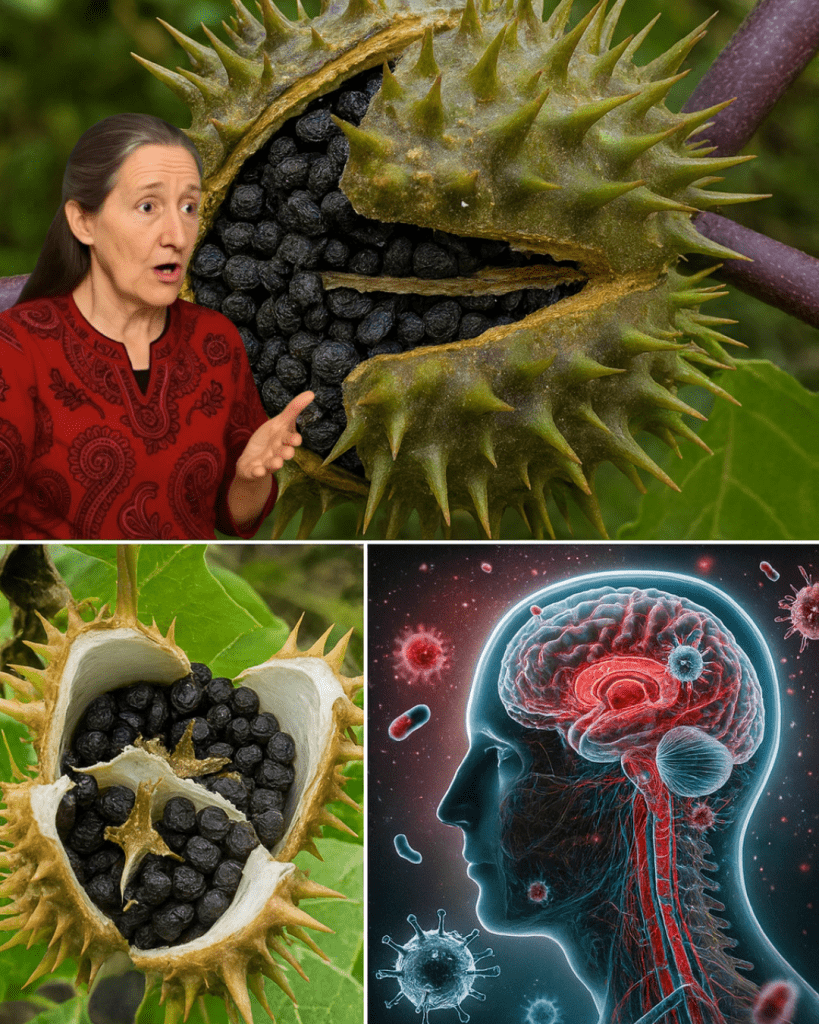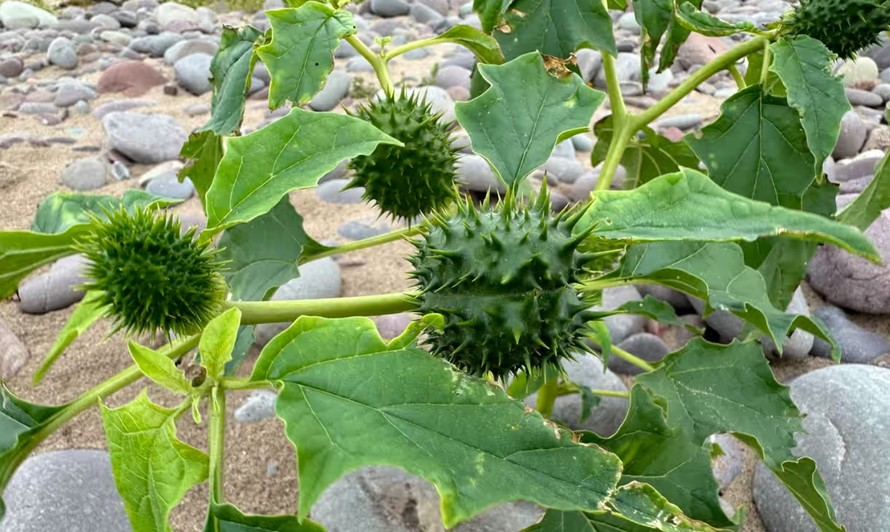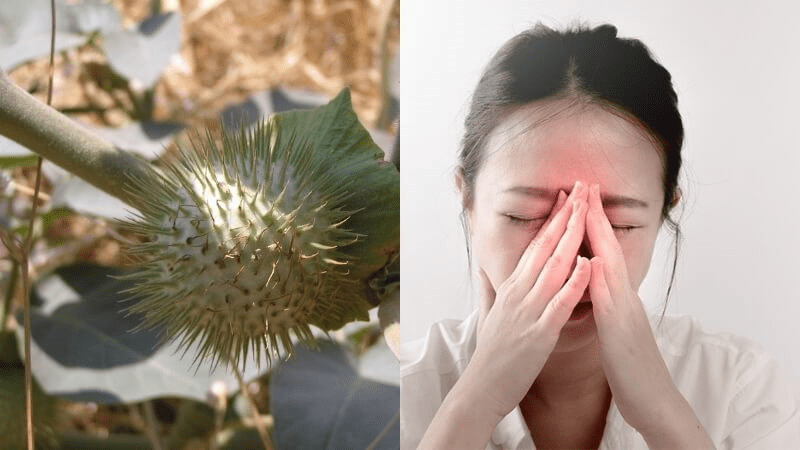Imagine stumbling upon a garden where flowers bloom with an otherworldly beauty, their trumpet-shaped petals glowing under the moonlight, whispering promises of mystery and enchantment. Now imagine those same flowers harboring a secret so deadly that a single touch could unravel your reality. This is the world of Datura, a genus of plants that captivates the eye and endangers the soul. Known for their hauntingly beautiful blooms and toxic allure, Datura plants are a paradox of nature—stunning yet sinister, inviting yet perilous. Dive into the enigmatic world of Datura, where beauty masks a lethal truth, and discover why this plant demands both your awe and your caution.

🌿 The Seductive Charm of Datura’s Appearance
Datura plants, belonging to the Solanaceae family, are a visual masterpiece. Their large, trumpet-shaped flowers, often in shades of white, purple, or yellow, unfurl at dusk, releasing a sweet, intoxicating fragrance that lures pollinators and curious humans alike. The genus includes about nine species, with Datura stramonium (Jimsonweed) and Datura metel (Devil’s Trumpet) being among the most notorious. Their lush, broad leaves and spiky seed pods add to their exotic appeal, making them a favorite in ornamental gardens. But beneath this aesthetic splendor lies a darker truth: every part of the Datura plant—leaves, flowers, seeds, and roots—is a reservoir of potent toxins.
The allure of Datura is not just in its beauty but in its ability to captivate. Gardeners and plant enthusiasts are often drawn to its striking presence, unaware of the risks it poses. The flowers’ nocturnal bloom cycle, glowing under moonlight, evokes a sense of mystery, almost as if they’re beckoning you closer. Yet, this is a siren’s call—one that could lead to dire consequences if you’re not careful.
☠️ A Toxic Legacy: The Deadly Chemistry of Datura
Datura’s danger lies in its chemical makeup. The plant is rich in tropane alkaloids, including atropine, scopolamine, and hyoscyamine, which are responsible for its toxic and psychoactive effects. These compounds can disrupt the central nervous system, causing a range of symptoms from mild hallucinations to severe delirium, seizures, and even death. Ingesting just a few seeds or a small portion of the plant can trigger a cascade of terrifying effects: dilated pupils, rapid heartbeat, confusion, and a distorted sense of reality.
What makes Datura particularly insidious is its unpredictability. The concentration of alkaloids varies widely between plants, parts, and even growing conditions, making it impossible to predict a “safe” dose. Historical accounts tell of accidental poisonings, with victims succumbing to the plant’s effects after mistaking it for an edible herb or brewing it into tea. Even handling the plant without gloves can lead to skin irritation or accidental absorption through mucous membranes.
🕯️ A Plant Steeped in Myth and History
Datura’s mystique extends beyond its biology into the realm of culture and history. Across centuries and continents, it has played roles in rituals, medicine, and folklore, often as a double-edged sword. Ancient civilizations, from the Americas to India, revered Datura for its psychoactive properties, using it in spiritual ceremonies to induce visions or connect with the divine. Shamans and healers carefully administered it, aware of its fine line between transcendence and toxicity.
In European folklore, Datura was associated with witchcraft and dark magic, earning names like “Witches’ Weed” and “Devil’s Trumpet.” Its ability to induce delirium made it a tool for those seeking to manipulate or curse, cementing its reputation as a plant of forbidden knowledge. Even today, Datura holds a place in modern subcultures, with some thrill-seekers experimenting with its effects, often with catastrophic results.

🌎 Where Datura Thrives: A Global Menace
Datura is a cosmopolitan genus, thriving in warm climates across the globe. Native to the Americas, it has spread to Africa, Asia, Australia, and Europe, often growing wild in disturbed soils like roadsides, fields, and abandoned lots. Its adaptability makes it a common sight in temperate and tropical regions, where it flourishes in sunny, well-drained environments. This resilience, combined with its prolific seed production, ensures that Datura is never far from human reach—a silent threat hiding in plain sight.
Gardeners may plant Datura for its ornamental value, but its invasive nature can quickly turn it into a pest. The plant’s seeds can remain viable in the soil for years, sprouting unexpectedly and spreading its toxic legacy. This makes Datura a challenge to control, especially in regions where it has naturalized.
⚠️ The Human Cost: Real-Life Dangers of Datura
The stories of Datura’s victims are chilling reminders of its power. Ingesting the plant, whether intentionally or accidentally, can lead to a nightmarish experience. Symptoms often begin within minutes: a dry mouth, blurred vision, and a racing heart give way to confusion, hallucinations, and loss of motor control. In severe cases, victims may fall into a coma or suffer respiratory failure. Emergency rooms worldwide have treated cases of Datura poisoning, often from teenagers or adults experimenting with its psychoactive effects, unaware of the risks.
Children are particularly vulnerable, drawn to the plant’s curious seed pods or vibrant flowers. A single seed pod can contain enough toxins to cause serious harm, making Datura a hidden danger in gardens and public spaces. Even animals are not immune—livestock and pets have been poisoned after grazing on Datura leaves or seeds.
🛡️ Staying Safe: How to Avoid Datura’s Trap
The best way to protect yourself from Datura is simple: keep your distance. If you encounter a plant with trumpet-shaped flowers and spiky seed pods, assume it’s dangerous until proven otherwise. Here are some practical tips to stay safe:
- Wear gloves when gardening near Datura to avoid skin contact with its toxins.
- Educate others, especially children, about the plant’s dangers and teach them not to touch or ingest unknown plants.
- Remove Datura from your garden if possible, using protective gear and disposing of the plant safely.
- Seek immediate medical help if you suspect Datura poisoning. Time is critical, as symptoms can escalate rapidly.
If you’re captivated by Datura’s beauty but want to avoid its risks, consider planting safer alternatives like morning glories or angel’s trumpets (Brugmansia, a related but less toxic genus). These plants offer similar aesthetic appeal without the lethal consequences.
🌌 The Psychological Pull: Why Datura Fascinates Us
Datura’s allure goes beyond its physical beauty—it taps into our fascination with the forbidden. The plant embodies the thrill of danger, the temptation to explore the unknown, and the human desire to push boundaries. Its dual nature as both a beautiful flower and a deadly poison mirrors our own complex relationship with nature: we are drawn to its wonders, yet we must respect its power.
This psychological pull keeps us coming back to Datura, whether through stories, gardening, or curiosity about its effects. It’s a reminder that beauty can be deceptive, and that some mysteries are best left untouched. By understanding Datura’s dangers, we can admire it from afar, appreciating its role in nature without falling prey to its deadly charm.

🌺 A Final Warning: Respect, Don’t Regret
Datura is a plant that demands respect. Its breathtaking beauty and rich history make it a captivating subject, but its toxic nature serves as a stark warning: not everything that enchants is safe. Whether you’re a gardener, a nature enthusiast, or simply someone intrigued by the strange and beautiful, Datura is a reminder to tread carefully in the natural world. Its flowers may beckon, but their embrace is one you’ll want to avoid.
Next time you spot a glowing, trumpet-shaped flower in a garden or along a roadside, pause and consider its story. Let Datura’s deadly allure remind you that some of nature’s most beautiful creations come with a price. Stay curious, stay cautious, and let this enigmatic plant remain a mystery you admire from a safe distance.









